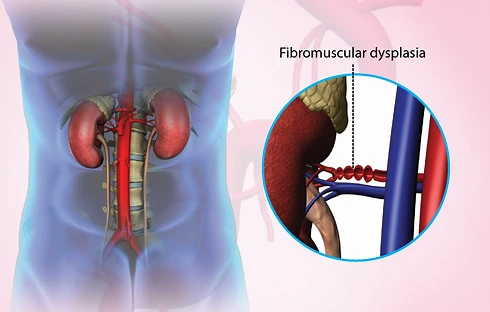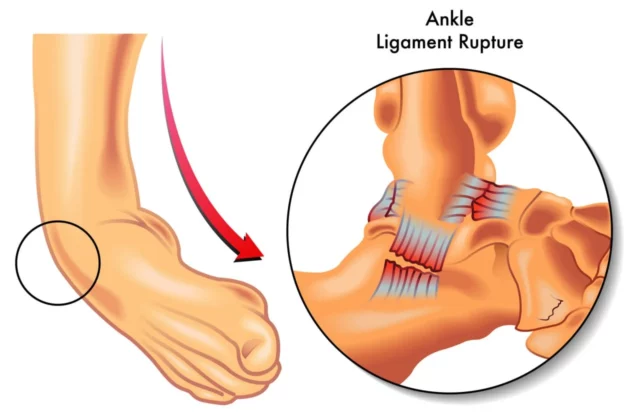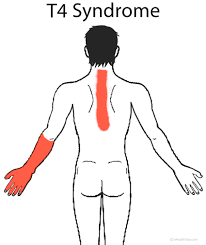Fibromuscular dysplasia
What is Fibromuscular dysplasia?
Fibromuscular dysplasia is a disease that causes the medium-sized arteries in your body to narrow (stenosis) and enlarge (aneurysm). Blood flow can be reduced and organ function can be affected by narrowed arteries.
Fibromuscular dysplasia manifests itself most commonly in the arteries leading to the kidneys and brain. Fibromuscular dysplasia can affect various arteries, including those leading to your heart, legs, abdomen, and, in rare cases, your arms. It’s possible that more than one artery is affected.
FMD generally involves medium-sized arteries that supply blood to the:
- kidneys (renal arteries)
- brain (carotid arteries)
- abdomen or intestines (mesenteric arteries)
- arms and legs
Less blood flow to these organs can conduct to permanent damage.
What are the types of fibromuscular dysplasia?
There are two varieties of FMD, established on the appearance of the arteries during diagnostic examinations.
Multifocal FMD is the most familiar. The arteries look like a series of beads, with a repeating design of bulging and then narrowing.
Focal FMD is much less familiar. It includes narrowed arteries or lesions on the arterial walls. A lesion is a region of abnormal tissue.
Symptoms of Fibromuscular Dysplasia
FMD doesn’t always generate symptoms. When it does, the symptoms rely on which organs are involved.
Symptoms of decreased blood flow to the kidneys contain:
- side pain
- High blood pressure
- shrinkage of the kidney
- abnormal kidney function when calculated by a blood examination
Symptoms of decreased blood flow to the brain contain:
- headache
- dizziness
- neck pain
- ringing or swooshing sound in ears
- droopy eyelids
- uneven-sized pupils
- stroke or ministroke
Symptoms of decreased blood flow to the abdomen contain:
- stomach ache after eating
- unexplained weight loss
Symptoms of decreased blood flow to the arms and legs contain:
- pain in the involved limb when walking or running
- weakness or numbness
- temperature or color shifts in the involved limb
Causes of Fibromuscular Dysplasia
The reason for fibromuscular dysplasia is unknown. Yet, several aspects might play a function.
Hormones. Investigators think female hormones might play a function in the development of the condition. Fibromuscular dysplasia is not connected to females’ use of birth control drugs, number of pregnancies, or age when they gave delivery.
Genetics. If a person in your family has fibromuscular dysplasia, you might get the disease, also.
Risk factors
Several items may make you more probable to create fibromuscular dysplasia.
Sex. Fibromuscular dysplasia is more familiar in females than it is in males.
Age. Although it can involve a person of any age, fibromuscular dysplasia tends to be diagnosed in people in their 50s.
Smoking. a patient who smokes appears to have a raised risk of creating fibromuscular dysplasia. For those already analyzed with the condition, smoking raises the risk for the more serious condition.
Differential Diagnosis
The differentials of fibromuscular dysplasia (FMD) contain but are not specified the following:
Atherosclerotic Renal Artery Stenosis
Specific characteristics contain older age, conventional cardiovascular risk factors, and stenosis involving the ostial and proximal portions of the artery compared to FMD affecting the middle and distal part of the artery in a younger woman.
Vasculitis
Vasculitides such as Takayasu arteritis, giant cell, and polyarteritis nodosa are differentiated from FMD by their significant inflammation.
Others
Rare diseases such as tuberous sclerosis, Marfan syndrome, alpha-1 antitrypsin deficiency, Alport syndrome, neurofibromatosis type 1, Ehlers-Danlos syndrome, moyamoya, and Williams syndrome can be complicated with FMD, but their phenotypic traits and genetics divide it. Segmental arterial dialysis has been defined in the books to mimic FMD radiographically due to its noninflammatory and nonatherosclerotic nature. The standard difference is by the characteristic histological appearance of vacuolar degeneration of smooth muscles in the external media.
Diagnosis
Your doctor might inspect for the disease if he or she hears an abnormal sound in your upper stomach region or your neck that could be generated by narrowed arteries. If a person in your family has or had fibromuscular dysplasia or aneurysm, your doctor might suggest inspecting you for the disease, even if you have no signs or symptoms.
Your doctor will conduct a physical examination and order blood examinations, involving blood sugar and cholesterol levels, to inspect for signs of atherosclerosis, another disease that can narrow your arteries.
Examinations to diagnose fibromuscular dysplasia could contain:
Duplex ultrasound. This noninvasive imaging examination can decide if an artery is narrowed. A device known as a transducer is pressed to your skin to transmit sound waves into your body. They bounce off cells and body structures, displaying how quickly your blood flows and the size and shape of the blood vessels.
CT angiogram. This examination delivers cross-sectional pictures of your body, which can display narrowing in the arteries, aneurysms, and dissections. You lie on a narrow tableland, which slides via a doughnut-shaped scanner. Before the examination beginnings, you’ll obtain an injection of a dye, which highlights the regions of the body being studied.
Magnetic resonance (MR) angiogram. This examination uses a magnetic field and radio waves to produce pictures of the body. It can notice if you have an aneurysm or dissection. During the examination, you’ll lie on a narrow table that slides into a tubelike device that’s open on both ends. Before the examination beginnings, you might obtain an injection of a dye, which highlights regions of the body being analyzed.
Catheter-based angiography. During this generally used examination for fibromuscular dysplasia, a narrow tube (catheter) is inserted into one of your arteries and moved until it gets to the site your doctor wants to study. A tiny quantity of dye is injected and X-rays are used to study the site.
The most familiar form of fibromuscular dysplasia looks like a series of beads on imaging examinations. Different states of fibromuscular dysplasia have a smooth focal appearance.
Once you’ve been analyzed with fibromuscular dysplasia, your doctor will observe you clinically. Sometimes, for instance, if you have an aneurysm, or if your symptoms alter, you may require repeat imaging to scan the arteries.
Treatment of Fibromuscular Dysplasia
Treatment for fibromuscular dysplasia relies on the symptoms, the area of the narrowed artery, and different health states you have, like high blood pressure. If you don’t require treatment at the time, your doctor might suggest watchful waiting.
Medications
Treatment with high blood pressure drugs is suggested for a person with fibromuscular dysplasia who have hypertension, even if they have a procedure to fix the disease. Several kinds of drugs are available:
Angiotensin-converting enzyme (ACE) inhibitors, like enalapril (Vasotec), benazepril (Lotensin), or lisinopril (Prinivil, Zestril), asset rest your blood vessels.
Angiotensin II receptor blockers. These drugs also assist to calm your blood vessels. Examples of this class of drugs involve irbesartan (Avapro), candesartan (Atacand), losartan (Cozaar), and valsartan (Diovan).
Diuretics. These medications, like hydrochlorothiazide (Microzide), are an asset to remove extra fluid from your body and may be used with further blood pressure drugs.
Calcium channel blockers, like nifedipine (Procardia) amlodipine (Norvasc), and others, assist to calm your blood vessels.
Beta-blockers, like atenolol (Tenormin), metoprolol (Lopressor), and others, delay your heartbeat and block adrenaline.
Your doctor might suggest you take an everyday aspirin to decrease your risk of stroke. But don’t begin to bring an aspirin without talking to your doctor first.
Some drugs used to manage hypertension can involve the way your kidneys work. Your doctor might suggest blood and urine examinations to make sure your kidneys are working usually once you begin taking these drugs.
Surgery
Percutaneous transluminal angioplasty (PTA)
This method is chosen over surgery and is generally done at the same time as a catheter-based angiogram. During an angiogram, dye is injected via a catheter into an artery. X-rays display how the dye journeys via the artery, revealing narrowed regions. A wire is knitted to the artery, and a catheter with a balloon is inserted into the narrowed region.
The balloon is then inflated to open the narrowed portion of the artery. Infrequently, a metal mesh tube (stent) may be put inside the weakened portion of the artery to assist in controlling it from rupturing.
Surgical revascularization
Surgery to fix the damaged artery is infrequently suggested. It’s generally only done when there are difficulties. Yet, if PTA is not a choice and the narrowing of your arteries is extreme, your doctor might suggest a more invasive method with surgery to fix or replace the narrowed piece of the artery. The kind of surgery relies on the location of the narrowed artery and how injured the artery is.
Complications of Fibromuscular Dysplasia
Fibromuscular dysplasia can generate several difficulties, involving:
High blood pressure. The narrowing of the arteries of the kidneys generates higher pressure on your artery walls, which can conduct to additional artery damage, heart condition, or heart failure.
Dissected artery. Fibromuscular dysplasia and tears in the walls of your arteries frequently happen together. This method is known as arterial dissection or spontaneous coronary artery dissection (SCAD) when it happens in the arteries of the heart or coronaries. Dissections can restrict blood flow to the organ delivered by the damaged artery.
Aneurysms. Fibromuscular dysplasia can weaken the walls of the arteries it involves, forming a bulge (aneurysm). An aneurysm rupture can be life-threatening. Aneurysms require to be observed and occasionally need surgery to control rupture.
Stroke. If you have a dissected artery conducting to your brain or if an aneurysm in an artery to your brain ruptures, you can contain a stroke. High blood pressure also can raise your risk of a stroke.
Prognosis
Long-term data about the prediction of fibromuscular dysplasia (FMD) is lacking. The American Heart Association states that progression in FMD is uncommon, and it is challenging to accurately estimate progressive stenosis. Now, it is considered that FMD is a benign condition that is incidentally found. Of all the vessels, yet, involvement of the cranial nerves takes a grim prognosis in a young person. Ultimately, the disease is also affected by the dissection of the arteries, which can turn out to be catastrophic.
FAQ
Is fibromuscular dysplasia a heart disease?
Fibromuscular dysplasia (FMD) affecting the coronary arteries is an unusual but significant disease that can present as left ventricular dysfunction, acute coronary syndrome, or potentially sudden cardiac death.
What type of disease is fibromuscular dysplasia?
Fibromuscular dysplasia (FMD) is an infrequent blood vessel condition in which some of the strong, flexible cells of arteries are substituted with more fibrous cells. Fibrous cells are smallish strong and also slightly flexible. This modification in the composition of the arteries leads to their evolving more rigid and more prone to injury.
What age does fibromuscular dysplasia start?
Fibromuscular dysplasia (FMD) is a nonatherosclerotic noninflammatory vascular condition that primarily involves females from age 20 to 60, but may also happen in infants and kids, males, and seniors.
Can you live a normal life with FMD?
Though FMD is a vascular condition that does not have a treatment, most persons with FMD can resume leading high-quality, positively productive lives. You should speak to your FMD doctor regarding potential changes to your lifestyle in order the manage FMD.
What is the life expectancy of FMD?
FMD is generally a life-long disease. Yet, investigators haven’t found any proof that it reduces life expectancy, and many people with FMD live well into their 80s and 90s.






